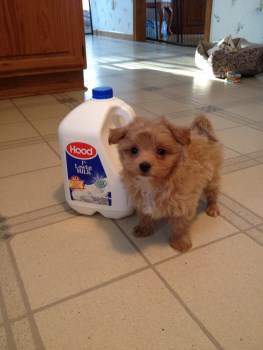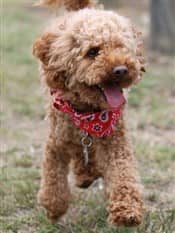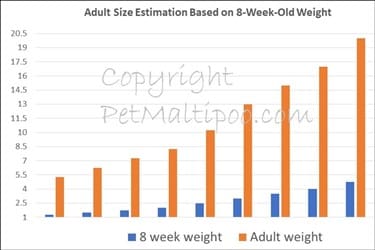Maltipoo Size
Overview
You may be wondering about Maltipoo size if you're thinking about getting one of these amazing hybrid dogs. Or, maybe you already have a Maltipoo; if you have a puppy you may be curious just how big your Maltipoo will grow to be and if you have an adult you may want to know how your little guy or gal compares to other Maltipoos.
No matter the case, this article will cover size classification, expected weight and height, and Maltipoo size compared to its parent breeds.
Please note:
PetMaltipoo is reader-supported. Some of the product suggestions on this page are affiliate links. As an Amazon Associate we earn from qualifying purchases. This is at no extra cost to you and helps us continue creating useful content.
Maltipoo Size Classification
Canines in General:
There are 5 general size classes for all dogs that are based on both weight and height, and all refer to a dog at their full adult size:
- Toy. This is the smallest size with most dogs between 3 and 10 pounds though the top maximum weight is 18 lbs. Height, which is measured when a dog is standing on all four feet, from the floor to the withers (which is the top of the shoulder blades), is generally between a tiny 6 inches to 10 inches.
- Small. There is some crossover between toy and small weights and heights, however most small breed dogs are 10 to 25 lbs.
- Medium. Again, there is some crossover, but most dogs considered medium-sized are in the 20 to 40 lb. range.
- Large. Dogs in this category generally fall between 55 and 85 lbs.
- Giant. There aren't that many dogs in this size class but those that are tower above the rest with weights over 100 lbs. and even 200 lbs., and height (measured from floor to withers while a dog is standing on all four feet) upward of 30 inches.
Maltipoos:
Because Maltipoos are a hybrid dog and not an official purebred dog, there is no official size classification. And, because there is no standardized breed guidelines, which would include exact physical traits such size, for breeders to strive for, there is still a lot of variation in Maltipoo size.
Maltipoos can range in size from a diminutive 3 pounds and a mere 6 inch height (measured floor to withers) to a sturdy 20+ pounds and height upward of 14 inches.
Keeping that wide range in mind, the some Maltipoos would be considered to be in the toy breed grouping and some would be considered to be in the small breed grouping. If the Maltipoo ever becomes recognized as an official breed, there would be a guideline regarding size (most likely weight, though height may be added in as well) which would help standardize size without so much variance.
Maltipoo Size as Reported by Owners
Adult Maltipoos can range in size from a tiny 3 pounds (1.36 kg) to a sturdy 20+ pounds (9 kg) with heights generally ranging from 6 to 14 inches (15.24 to 35.56 cm). But according to a comprehensive study involving 1,973 adult Maltipoos, the majority are between 7 and 13 pounds (3.1 and 5.8 kg). At this weight range, the height (from floor to top of the shoulder blades) will typically range from 8 to 12 inches (20.32 to 30.48 cm).
Though the entire breakdown and details can be seen in our article regarding Maltipoo weight, let's look at a summary of statistics from a comprehensive survey that we sent out to Maltipoo owners. There were 2,596 respondents of which 1,973 dogs were one year old and older.
In looking at all of the Maltipoos, reported weights ranged from 3 lbs. (just 1% of dogs) to 17+ pounds (6% of dogs).
The majority of adult Maltipoos (70%) were between 7 and 13 pounds (3.1 and 5.8 kg).
There were a small number of Maltipoos (10%) that were even tinier adults, between 3 and 6 pounds (1.36 and 2.7 kg).
And, 1/5 of adult Maltipoo dogs (20%) were 13 pounds and up. Most of these larger Maltipoos (14%) were between 13 and 17 pounds (5.8 to 7.7 kg) and a small percentage (6%) were more than 17 pounds (7.7 kg); the heaviest was a reported 25 pounds.
Maltipoo Size Compared to the Maltese and the Toy and Mini Poodle
You may at first wonder why a Maltipoo would be compared at all to a miniature Poodle; isn't it the toy Poodle that is one of this hybrid's 'parent' breeds?
Well, some time ago, before Maltipoos became such a popular hybrid dog, people were producing Maltipoos by pairing Maltese with toy Poodles and mini Poodles. There was not much rhyme or reason to it; most hobby breeders were simply using a toy or miniature Poodle based on which dog they happened to own or have access to via a friend or acquaintance.
Though the toy Poodle is more popular in the US than the miniature, the mini was indeed used which created a dramatic size variance that is still being worked out today. In time, as the Maltipoo started to become one of the most popular and sought-after 'designer' breeds, hobby breeders did try to become more focused by using only toy Poodles.
Now, with the Maltipoo's popularity soaring higher than ever, there are 2nd, 3rd, and further-back generations of dogs that are the result of Maltipoo to Maltipoo breeding. But, one problem with any efforts to narrow down the size of this breed is that those pairings still involve dogs with widely varying weights. Typically, you'll see Maltipoos all the way from 5 pounds to 20 pounds in breeding programs, thus producing litters that are predetermined to have a wide range of sizes, from teeny-tiny to good-sized and sturdy.
This said, let's look at the size differences between these breeds:
Most adult Maltipoos are between 7 and 13 pounds (3.1 and 5.8 kg) and with a height range of 8 to 12 inches (20.32 to 30.48 cm). Pictured here is Gosha at 8 months old, photo courtesy of Victoria
The Maltese is in the AKC toy group, with an AKC breed standard size of under 7 pounds and an unofficial height of 8 to 10 inches.
Per AKC breed standards, toy Poodles have an official height of 10 inches or under and an unofficial weight range of 6 to 9 pounds for those shown in conformation events. Pet toy Poodles have a larger ranges in size.
Estimating Adult Size
If you have a Maltipoo puppy and are wondering what their adult size will be, this can somewhat be estimated by looking at the pup's current weight. But, since growth is not linear and there are spurts and stalls, it is indeed just an approximation.
Estimating adult size for an 8-week old Maltipoo puppy:
A helpful guideline is that if a Maltipoo pup is 2.50 pounds or under at 8-weeks-old, an estimate for adult size is the puppy weight multiplied by 4, with .25 added. And if a puppy is 2.75 pounds or more at 8-weeks-old, an estimate for adult size is the puppy weight multiplied by 4, with 1 pound added.
Estimating adult size of a 4-month old Maltipoo puppy:
As a general rule, if you take the size of a Maltipoo at 4 months old and double that, it should be within a pound or two of his/her final adult size.
You don't have to wait very long to see what size your Maltipoo will be since most are finished growing by the 10 to 12-month mark.
Below you will see a Maltipoo Adult Size Estimation Chart
based on 8-week old weight.
When is a Maltipoo Considered Under-sized?
For breeds that have set weights via breed standard guidelines, it's easy to know when a certain dog is under-sized. But, what about with the Maltipoo? Well, it's safe to say that since most Maltipoo are between 7 and 13 pounds (3.1 and 5.8 kg), that at the very least a fully-grown adult Maltipoo that is under 7 pounds is smaller than most.
And, since we know from our survey that reported weights for 1,973 adult Maltipoo dogs showed none were smaller than 3 pounds, it is safe to say that these 'smaller than average' Maltipoo will be between 3 and 6 pounds (1.36 to 2.7 kg).
Care for Under-sized Maltipoo Dogs
For small dogs in general, but particularly for adults with a single-digit weight (under 10 pounds - 4.5 kg), there are certain care elements that should be followed to help prevent some of the most commonly seen issues with tiny dogs.
1. Consider your Maltipoo an 'under the foot' dog.
This is a term given to tiny dogs that can quickly and quietly appear under your feet without you noticing. This can cause an owner to accidentally trip over their dog or step on them which can cause bad injuries. Always maintain situational awareness, especially when going around corners or entering into an unlit room where your dog may be.
2. When picking up your Maltipoo, always use 2 hands.
You will want to place one under its rear and the other hand should be placed across its chest. While you do not want to use too much force, it is important to use commonsense so that your dog is held firmly enough that he or she cannot wiggle out of the hold and fall to the ground. When placing your Maltipoo back down, again use both hands to guide them to the floor so that the entire body gently touches down without any jarring.
3. Do not allow children to handle your Maltipoo unless they are able to follow proper handling techniques.
Aside from the previous instructions regarding how to pick up a small Maltipoo, other guidelines for children include no roughhousing, no pulling the dog's tail, and no poking.
4. Feed your Maltipoo multiple times per day.
Tiny dogs are very prone to hypoglycemia which is a rapid drop in blood sugar levels that can lead to coma or even death in severe cases. Signs include dizziness, confusion, and lethargy. Giving your little Maltipoo 3 small meals per day, plus several dry snacks can help prevent this.
Though moderate to severe cases are considered to be an emergency and need to be treated at the vet's, minor cases can often be treated at home by rubbing a dab of honey onto the gums which can help stabilize blood sugar levels.
5. Use a harness, not a collar.
Collapsed trachea is an issue seen most often with small dogs including Maltipoos. This is a painful condition that involves tracheal rings that surround the windpipe weakening and collapsing inward. Signs include a honking-type cough or sounds of gagging. While some cases are genetic and rings are predisposed to degenerate, it is wise to not use a collar since these place tension and pressure directly on a dog's neck.
So, if you are wondering which collar is best for a Maltipoo, the answer is, none. A harness is best.
An easy step-in design like the Puppia Soft B Harness Vest
 distributes pressure over the chest, shoulders, and back. An added plus is that you'll have much better control over your dog this way. And, these are super-comfortable. There is nothing that needs to be slipped over the head and the material is an air-mesh that keeps a dog cool.
distributes pressure over the chest, shoulders, and back. An added plus is that you'll have much better control over your dog this way. And, these are super-comfortable. There is nothing that needs to be slipped over the head and the material is an air-mesh that keeps a dog cool.

This is Betsy, a 10 week old Maltipoo that is 3 pounds.
Photo courtesy of Joan Swartz
When is a Maltipoo Considered Over-sized?
Just as with under-sized Maltipoo, it would be easier to give a specific answer if there were breed guidelines that offered set weight and heights. So, there are two elements involved with this.
The first is to look at the statistics that most Maltipoo (70%) are between 7 and 13 pounds (3.1 and 5.8 kg). And, if you consider all reported weights in our survey, 80% of Maltipoo are between 3 and 13 pounds (1.36 to 5.8 kg).
So, this lets us know that a small percentage of Maltipoo (20%) are over 13 lbs. which would make them 'larger than average'.
However, that is just part of the equation because larger does not necessarily mean over-sized in regard to carrying excess weight. As mentioned earlier, canines range in size from teeny toy breeds to massive giant breeds. A 13+ pound Maltipoo can have larger bone structure than his smaller counterparts and be perfectly healthy.
In fact, larger dogs are more sturdy and less prone to size-related injuries like being stepped on or dropped and there are fewer cases of size-related health issues seen with very small dogs such as hypoglycemia and collapsed trachea.
If you have a Maltipoo that falls on the higher end of the weight range (in the teens or twenties) and are not sure if it is due to natural bone structure or carrying excess weight, the veterinarian is the best person to assess this for you. That said, a method you can use at home (just for an initial assessment) is to look at and feel your dog's rib cage when the coat is wet (such as bath-time).
If you can clearly see the outline of the ribs and easily feel them, your dog is most likely not carrying excess weight. And, if you cannot see any sort of outline and you have a hard time feeling any of the rib bones, this is a sign that there may be too much body fat.
ssss







